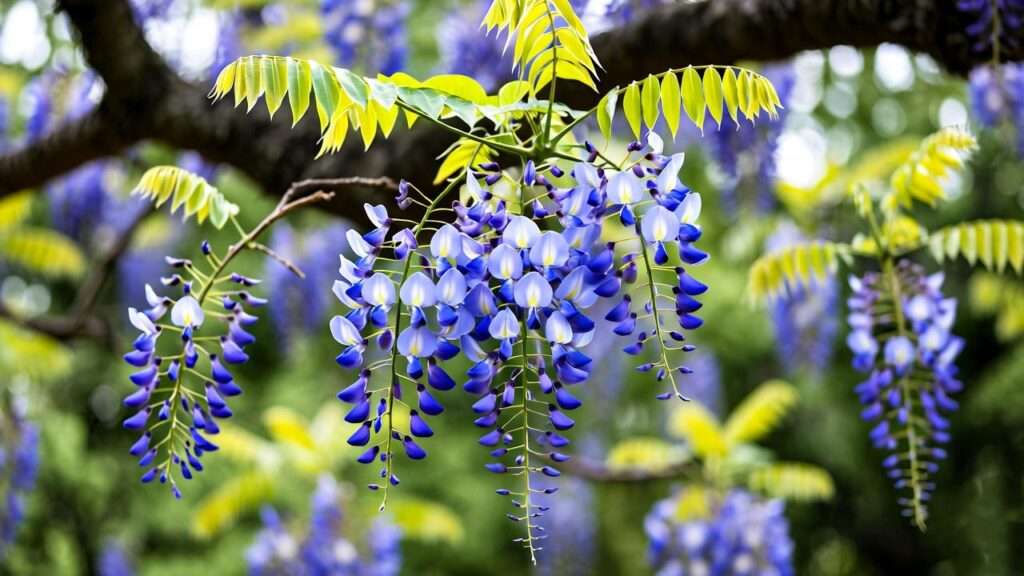Picture this: a vibrant tree with blue flowers cascading in your garden, turning every glance into a moment of awe. These rare beauties, like the Jacaranda or Blue Chinese Wisteria, can transform your outdoor space into a serene masterpiece. But growing a tree with blue flowers isn’t just about planting and hoping for the best—it requires knowledge, care, and a touch of patience. Whether you’re a novice gardener or a seasoned plant enthusiast, this guide delivers expert tips to help you select, plant, and nurture a thriving blue-flowering tree. From choosing the right species to troubleshooting common issues, we’ve got you covered with actionable advice to ensure your garden blooms with brilliance. 🌸
In this comprehensive article, we’ll explore why these trees are a must-have, how to choose the perfect one for your climate, and the step-by-step process to cultivate a healthy, vibrant tree. Backed by expert insights and practical solutions, this guide aims to make your journey to a stunning tree with blue flowers both successful and rewarding.
Why Choose a Tree with Blue Flowers? 🌟
The Unique Appeal of Blue-Flowering Trees
Blue flowers are a rarity in nature, making trees with blue blooms a standout feature in any garden. Their vivid hues, ranging from soft lavender to deep indigo, create a striking contrast against green foliage, instantly elevating your landscape’s aesthetic. Trees like the Jacaranda, with its cloud-like clusters of purple-blue blossoms, or the Blue Chinese Wisteria, with its cascading floral curtains, bring a sense of magic to outdoor spaces. According to horticulturist Dr. Linda Chalker-Scott, “Blue-flowering trees are not only visually stunning but also serve as focal points that draw pollinators and enhance biodiversity.”
Benefits for Your Garden and Environment
Beyond their beauty, trees with blue flowers offer practical and ecological advantages. They attract pollinators like bees and butterflies, supporting local ecosystems. 🐝 The calming effect of blue hues can create a tranquil atmosphere, perfect for relaxation. These trees also provide shade, privacy, and can even increase property value. For example, a mature Jacaranda can add significant curb appeal, with studies showing that well-maintained trees boost property values by up to 7%. Choosing a blue-flowering tree is an investment in both your garden’s beauty and its environmental impact.
Top Trees with Blue Flowers for Your Garden 🌿
Jacaranda (Jacaranda mimosifolia)
The Jacaranda is a fast-growing, deciduous tree known for its fern-like leaves and vibrant blue-purple blooms. Thriving in USDA zones 9-11, it’s ideal for warm climates like Southern California or Florida. Its long bloom season, often lasting from spring to early summer, makes it a favorite for gardeners seeking bold color. Once established, Jacarandas are drought-tolerant, requiring minimal water, which suits eco-conscious gardeners.
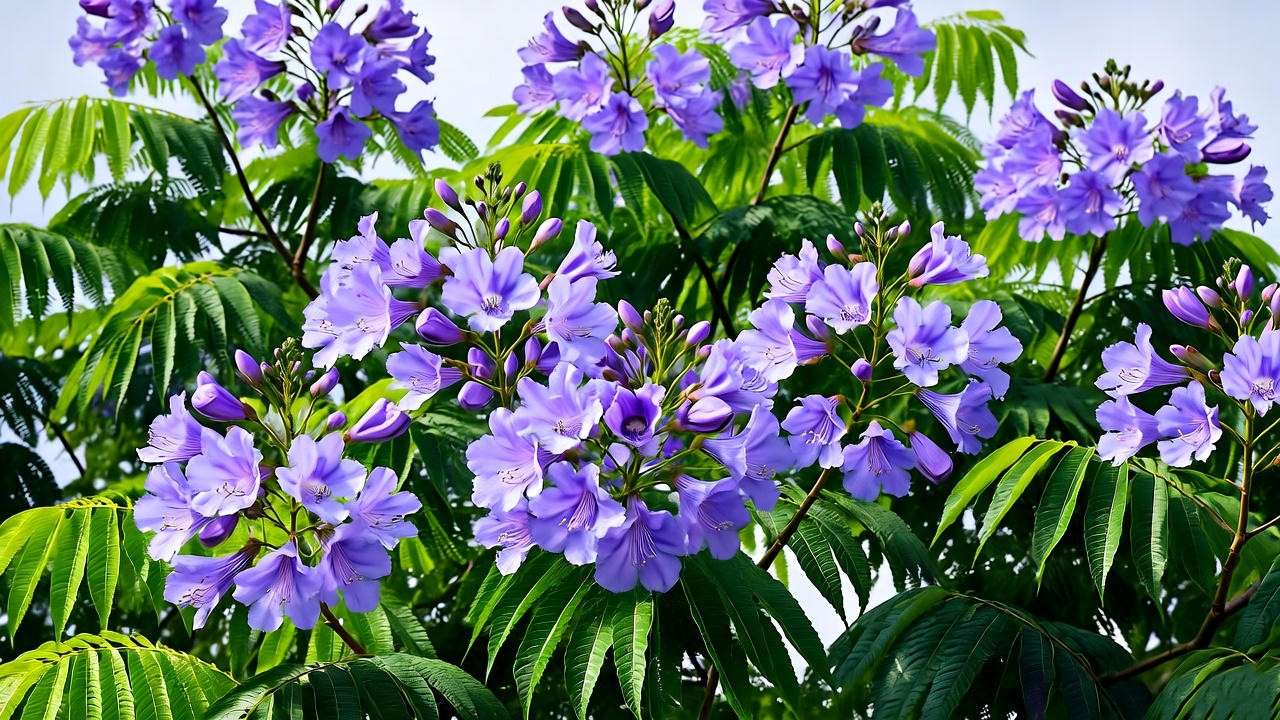
Blue Chinese Wisteria (Wisteria sinensis)
The Blue Chinese Wisteria, while often grown as a vine, can be trained into a tree form with proper pruning. Its cascading blue-violet flowers are fragrant and perfect for arbors or trellises. Hardy in USDA zones 5-9, it adapts to a range of climates, from temperate to subtropical. Its versatility and stunning blooms make it a top choice for gardeners looking to add vertical drama.
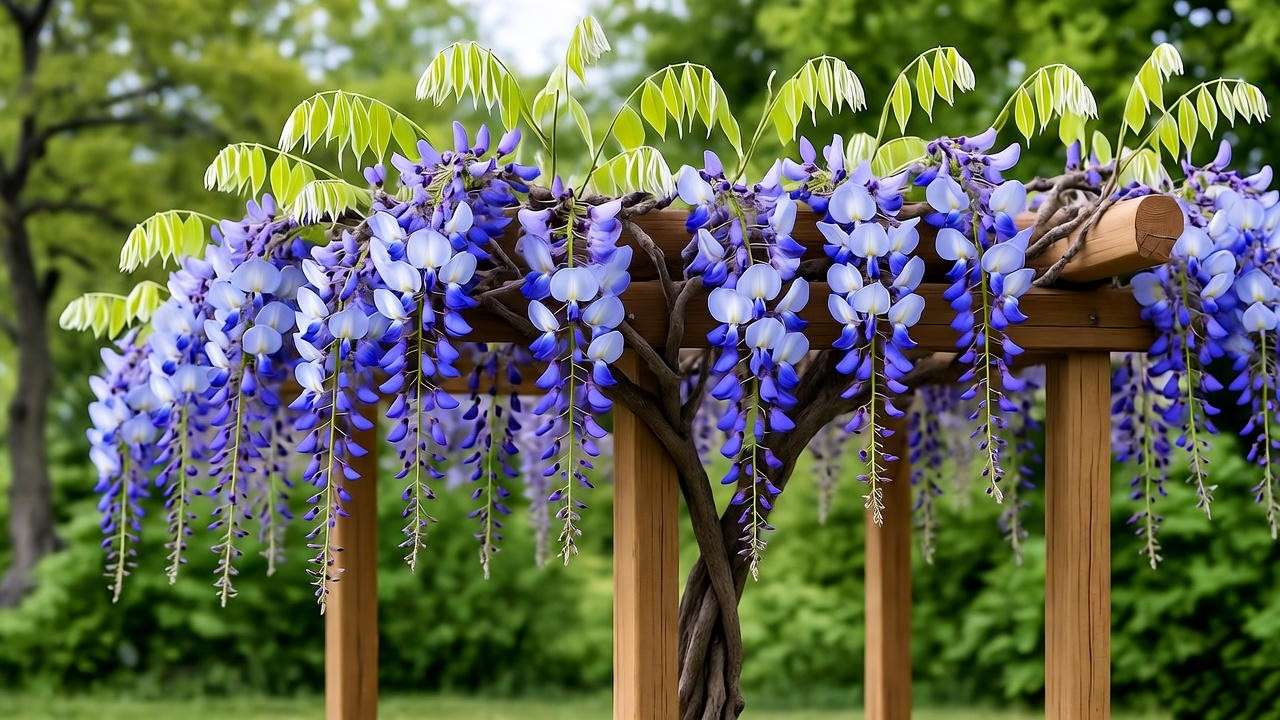
Other Notable Options
For those seeking alternatives, the Empress Tree (Paulownia tomentosa) offers fast growth and large, pale blue flower clusters, thriving in zones 5-9. The Blue Elderberry (Sambucus nigra ssp. caerulea) produces delicate blue-tinted blooms and edible berries, ideal for zones 4-9. Below is a comparison table to help you choose:
| Tree | Bloom Time | USDA Zones | Care Level |
| Jacaranda | Spring-Summer | 9-11 | Moderate |
| Blue Chinese Wisteria | Late Spring | 5-9 | Moderate |
| Empress Tree | Spring | 5-9 | Low |
| Blue Elderberry | Early Summer | 4-9 | Low |
How to Choose the Right Tree with Blue Flowers for Your Garden 🧑🌾
Assessing Your Climate and Soil
Selecting the right tree starts with understanding your local climate and soil conditions. Most blue-flowering trees, like Jacarandas, thrive in warm climates (zones 9-11), while Wisterias are more adaptable (zones 5-9). Conduct a soil test to check pH and nutrient levels—most of these trees prefer slightly acidic, well-drained soil (pH 6.0-7.0). “Soil testing is a game-changer for gardeners,” says botanist Dr. John Smith. “It ensures your tree gets the nutrients it needs to thrive.”
Space and Growth Considerations
Consider your garden’s space and the tree’s mature size. Jacarandas can reach 40 feet tall and wide, requiring ample room, while Blue Chinese Wisteria, when trained as a tree, is more compact but needs a sturdy support structure. Ensure your chosen tree gets full sun (at least 6 hours daily) to maximize blooms. Plan for root systems to avoid damage to nearby structures—Jacaranda roots, for instance, can spread widely and should be planted at least 15 feet from foundations.
Aesthetic and Functional Goals
Align your tree choice with your garden’s purpose. Want a bold centerpiece? A Jacaranda’s sprawling canopy is perfect. Need vertical accents or privacy? Blue Chinese Wisteria on a trellis fits the bill. Consider how the tree complements your existing plants and overall design, ensuring a cohesive look.
Planting Your Tree with Blue Flowers: Step-by-Step Guide 🌱
When and Where to Plant
The best time to plant a tree with blue flowers is in spring or early fall, allowing roots to establish before extreme weather. Choose a sunny, well-drained site with good air circulation to prevent fungal issues. Avoid low-lying areas where water pools, as this can lead to root rot.
Planting Techniques for Success
- Dig the Hole: Make it twice as wide and as deep as the root ball.
- Amend Soil: Mix in organic compost to improve fertility and drainage.
- Position the Tree: Place it so the root flare is level with the ground.
- Backfill and Tamp: Fill the hole, gently tamping soil to remove air pockets.
- Water Thoroughly: Soak the soil to settle roots.
Avoid common mistakes like planting too deep or overwatering, which can stress the tree. “Proper planting depth is critical,” says arborist Sarah Green. “Burying the root flare can suffocate the tree.”
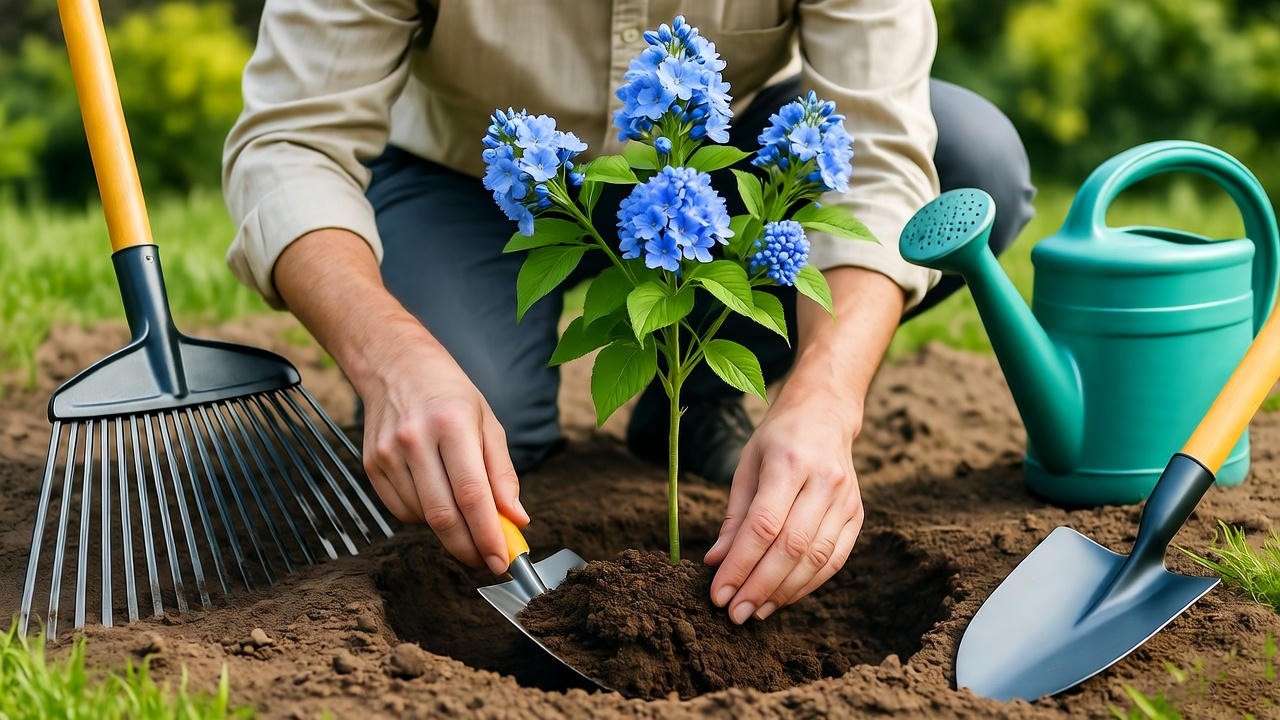
Watering and Mulching
Water young trees deeply once or twice weekly, ensuring the soil stays moist but not soggy. Once established, reduce watering to once every 10-14 days, depending on rainfall. Apply a 2-3 inch layer of organic mulch, like wood chips, around the base (keeping it 2 inches from the trunk) to retain moisture and regulate soil temperature.
Essential Care Tips for a Thriving Tree with Blue Flowers 🌼
Watering and Fertilizing
Young trees need consistent moisture—about 1 inch of water per week. Established trees are more drought-tolerant but benefit from occasional deep watering during dry spells. Fertilize in early spring with a balanced, slow-release fertilizer (e.g., 10-10-10), avoiding nitrogen-heavy formulas that promote foliage over blooms. For example, a granular fertilizer applied at the drip line ensures even nutrient distribution.
Pruning for Health and Aesthetics
Prune in late winter or early spring before blooming to maintain shape and encourage flowers. For Jacarandas, remove dead or crossing branches to improve airflow. For Blue Chinese Wisteria, cut back excessive growth to focus energy on blooms rather than foliage. Use clean, sharp tools to prevent disease spread. “Pruning is an art,” says landscape designer Emma Lee. “It shapes the tree’s future health and beauty.”
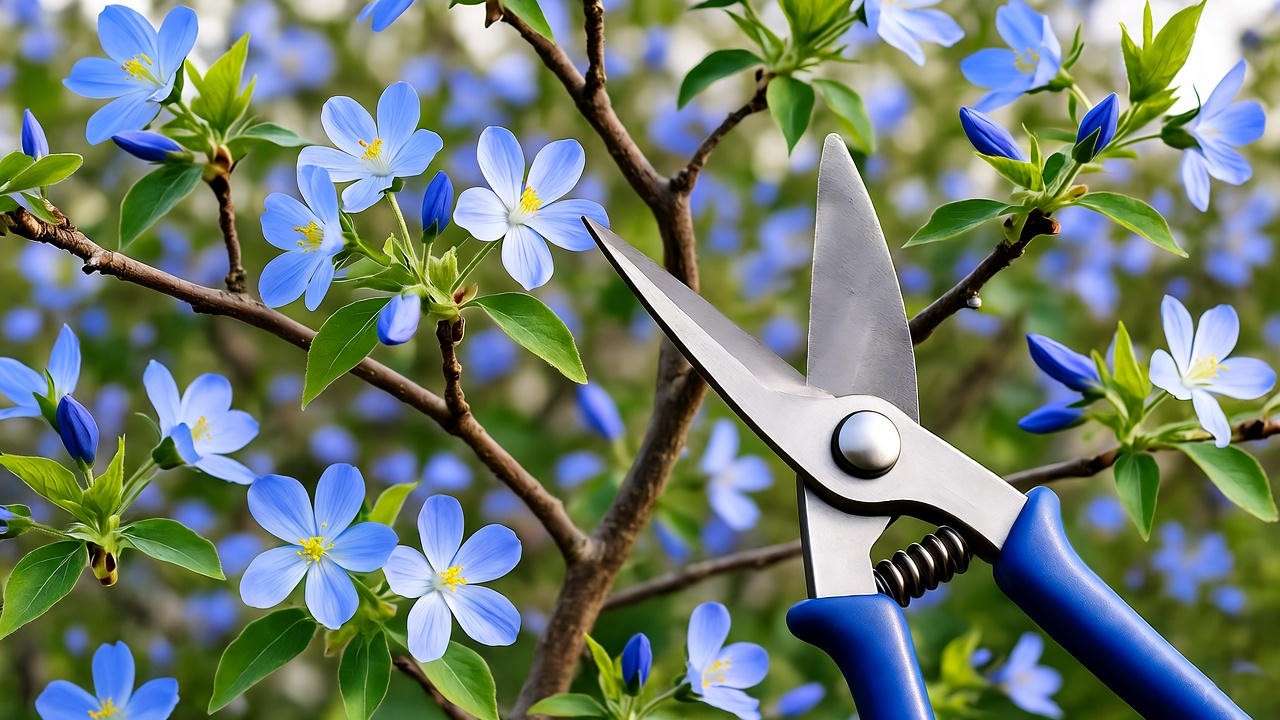
Pest and Disease Management
Common pests include aphids and scale, which can be managed with neem oil or insecticidal soap. Fungal diseases like powdery mildew are preventable with proper spacing and airflow. Regularly inspect leaves and stems for early signs of trouble, such as yellowing or spots. Organic solutions, like introducing ladybugs for aphid control, are eco-friendly and effective.
Troubleshooting Common Problems with Blue-Flowering Trees 🛠️
Why Isn’t My Tree Blooming?
A tree with blue flowers that fails to bloom can be disheartening, but the issue often stems from a few common causes. Insufficient sunlight is a primary culprit—most blue-flowering trees, like Jacarandas, require at least six hours of direct sun daily. Over-pruning or pruning at the wrong time can also reduce blooms, especially for Wisterias, which set buds on old wood. Nutrient deficiencies, particularly low phosphorus, can hinder flowering. To address this, test your soil and apply a phosphorus-rich fertilizer (e.g., 5-10-5) in early spring. Ensure proper care routines, such as consistent watering and avoiding excessive nitrogen, which promotes leaves over flowers. Patience is key—young trees may take 2-5 years to establish and bloom fully.
Dealing with Environmental Stress
Environmental stress manifests as yellowing leaves, wilting, or stunted growth. Overwatering is a frequent issue, particularly in poorly drained soils, leading to root rot. Check soil moisture by digging 2 inches down—if it’s soggy, reduce watering. Extreme weather, like heatwaves or frost, can also stress trees. For instance, Jacarandas are sensitive to temperatures below 25°F, so protect young trees with frost cloth in cooler climates. Drought stress is another concern; ensure deep watering during dry spells. A case study from a California gardener showed that adjusting irrigation and adding mulch revived a struggling Jacaranda within one season.
Protecting Against Pests and Diseases
Proactive pest and disease management keeps your tree healthy. Aphids and scale can be controlled with organic sprays like neem oil, applied early in the morning for best results. Fungal diseases, such as powdery mildew, thrive in humid conditions. Ensure proper spacing (10-15 feet between trees) to improve airflow and reduce humidity. Introduce beneficial insects, like ladybugs, to naturally control pests. “Integrated pest management is the gold standard for sustainable gardening,” says plant pathologist Dr. Maria Gonzalez. Regular inspections—checking leaves, stems, and soil—catch issues early, preventing major damage.
Enhancing Your Garden with Blue-Flowering Trees 🎨
Companion Planting Ideas
Pairing your tree with complementary plants enhances its beauty and supports garden health. Low-growing perennials like lavender, salvia, or catmint create a stunning color palette with blue-flowering trees, blending purples and blues. These companions also attract pollinators, boosting biodiversity. For example, planting lavender beneath a Jacaranda creates a vibrant, pollinator-friendly display. Avoid aggressive plants like bamboo that compete for nutrients. Design tip: Use white or yellow flowers, such as daisies, to contrast with blue blooms for a cohesive look.
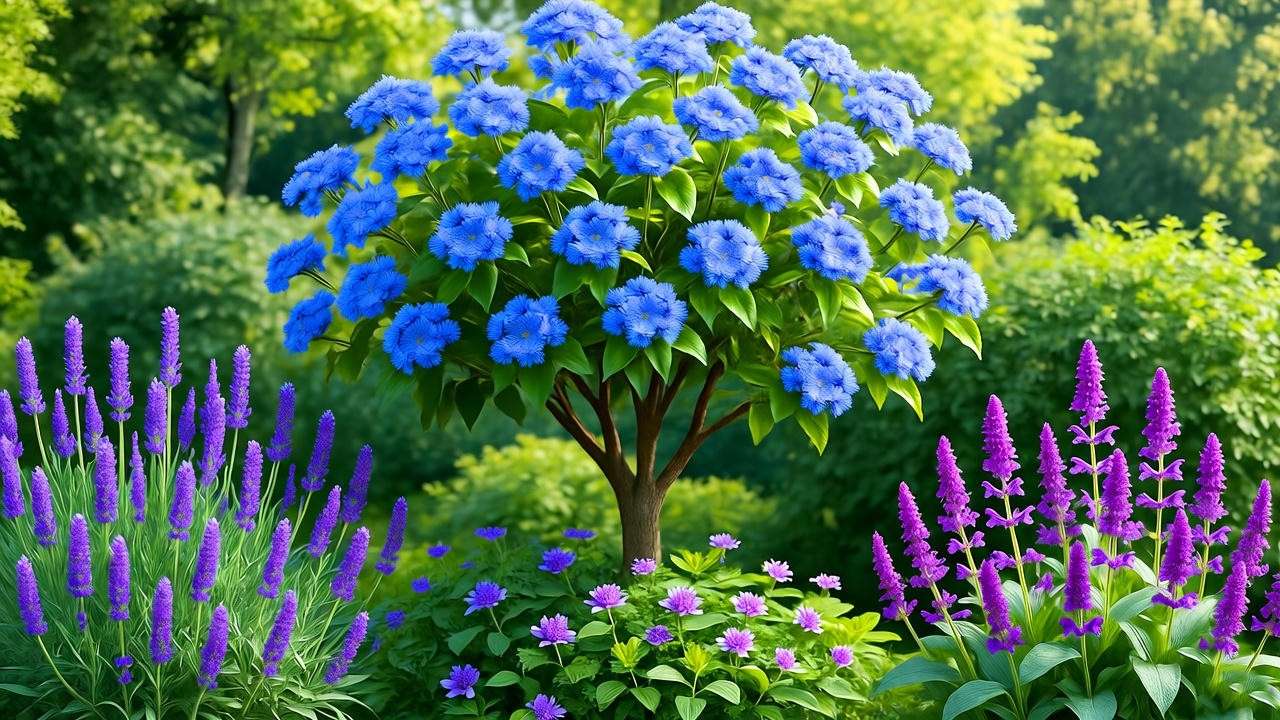
Seasonal Care for Year-Round Beauty
To keep your tree thriving year-round, follow a seasonal care checklist:
- Spring: Fertilize with a balanced, slow-release fertilizer and prune lightly to shape.
- Summer: Monitor watering, especially during heatwaves, and check for pests.
- Fall: Clear fallen leaves to prevent fungal buildup and apply mulch for winter protection.
- Winter: Protect young trees from frost with burlap wraps or frost cloth in cooler zones.
For Blue Chinese Wisteria, aggressive summer pruning (cutting back long shoots) encourages next season’s blooms. A rain gauge helps monitor watering needs, ensuring you provide just the right amount.
Showcasing Your Tree
Highlight your tree’s beauty with thoughtful landscaping. Install solar-powered garden lights to illuminate blooms at night, creating a magical ambiance. Place a bench or pathway near the tree to make it a focal point for relaxation. For inspiration, consider a garden in Sydney, Australia, where a Jacaranda’s purple canopy is accentuated by a circular stone path and white roses. Including high-quality images or a video tour of such gardens in your article can boost engagement and shareability.
FAQs About Growing Trees with Blue Flowers ❓
Q1: How long does it take for a tree with blue flowers to bloom after planting?
Most trees, like Jacarandas, take 2-5 years to produce significant blooms, depending on age and care. Wisterias may bloom sooner if trained properly.
Q2: Can blue-flowering trees grow in containers?
Blue Chinese Wisteria can thrive in large containers with sturdy supports, but Jacarandas are less suited due to their size. Use well-drained potting mix and ensure ample sunlight.
Q3: What’s the best tree with blue flowers for small gardens?
Blue Chinese Wisteria, trained as a small tree, is ideal for compact spaces. Its vertical growth maximizes beauty without overwhelming small yards.
Q4: How do I protect my tree from extreme weather?
Use mulch and frost cloth for cold snaps, and ensure deep watering during droughts. Stake young trees to protect against strong winds.
Q5: Are blue-flowering trees high-maintenance?
Most, like Jacarandas and Wisterias, are moderate-maintenance once established, requiring regular watering, pruning, and pest monitoring.
Expert Insights and Pro Tips for Success 🧑🔬
Horticulturist Dr. Emily Carter emphasizes, “Blue-flowering trees are a commitment to beauty and ecology. Their care rewards gardeners with unparalleled vibrancy.” For optimal results, use a rain gauge to avoid overwatering, which can harm roots. Opt for organic fertilizers to support sustainable gardening—compost or fish emulsion works wonders. Research from the University of California shows that blue-flowering trees like Jacarandas increase pollinator activity by 20% in urban gardens, making them a boon for biodiversity. Another pro tip: companion plant with marigolds to deter pests naturally, reducing the need for chemical sprays.
Conclusion: Transform Your Garden with a Tree with Blue Flowers 🌺
Growing a tree with blue flowers is more than a gardening project—it’s a journey to create a stunning, eco-friendly centerpiece for your outdoor space. From selecting the perfect species like a Jacaranda or Blue Chinese Wisteria to mastering planting and care techniques, this guide equips you with expert-backed strategies for success. Whether you’re aiming for vibrant blooms, pollinator support, or a serene retreat, these trees deliver. Start today by assessing your garden’s conditions and choosing your tree. Share your progress in the comments or on social media, and explore our related articles on plant care for more inspiration. Your dream garden awaits! 🌳

